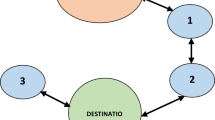Abstract
Mobile ad hoc network is open medium and infrastructure-less network. Mobile ad hoc network is susceptible to various security attacks such as, black hole attack, gray hole attack, bad mouthing attack, sybil attack and worm hole attack due to open medium, infrastructure-less features and lack of in-built security. In black hole attack and gray hole attack, attacker falsely sends route reply and dropped data packets received from source node. Due to these attacks, performance of mobile ad hoc network decreases. This paper proposes a time stamp-based algorithm which is an enhanced version of existing IDSNAODV algorithm. Proposed algorithm modifies existing palling process to validate identity of observer nodes using a time stamp-based approach. Based on defined set of rules and recorded activities report, source node decides the nature of target node. The performance of proposed algorithm is evaluated using the network simulator. The proposed algorithm shows improved performance for packet delivery ratio, throughput and routing overhead as compared to existing algorithm.




Similar content being viewed by others
References
Alkhamisi, A. O., & Buhari, S. M. (2016). Trusted secure adhoc on-demand multipath distance vector routing in MANET. In 30th International conference on advanced information networking and applications (AINA) (pp 212–219). IEEE.
Moudni, H., Er-rouidi, M., Mouncif, H., & El Hadadi, B. (2016). Modified AODV routing protocol to improve security and performance against black hole attack. In International conference on information technology for organizations development (IT4OD) (pp. 1–7). IEEE.
Chang, J. M., Tsou, P. C., Woungang, I., Chao, H. C., & Lai, C. F. (2015). Defending against collaborative attacks by malicious nodes in MANETs: A cooperative bait detection approach. IEEE Systems Journal, 9(1), 65–75.
Shahabi, S., Ghazvini, M., & Bakhtiarian, M. (2015). A modified algorithm to improve security and performance of AODV protocol against black hole attack. Wireless Networks, 22(5), 1505–1511.
Mylsamy, R., & Sankaranarayanan, S. (2016). A preference-based protocol for trust and head selection for cluster-based MANET. Wireless Personal Communications, 86(3), 1611–1627.
Babu, M. R., Dian, S. M., Chelladurai, S., & Palaniappan, M. (2015). Proactive alleviation procedure to handle black hole attack and its version. The Scientific World Journal, 2015, 715820. https://doi.org/10.1155/2015/715820.
Raja, K., Deivasigamani, A., & Ravi, V. (2015). A reliant certificate revocation of malicious nodes in MANETs. Wireless Personal Communications, 90(2), 435–455.
Shabut, A. M., Dahal, K. P., Bista, S. K., & Awan, I. U. (2015). Recommendation based trust model with an effective defence scheme for MANETs. IEEE Transactions on Mobile Computing, 14(10), 2101–2115.
Kumar, J. M. S. P. J., Kathirvel, A., Kirubakaran, N., Sivaraman, P., & Subramaniam, M. (2015). A unified approach for detecting and eliminating selfish nodes in MANETs using TBUT. EURASIP Journal on Wireless Communications and Networking, 2015(1), 1–11.
Jain, A. K., & Tokekar, V. (2015). Mitigating the effects of Black hole attacks on AODV routing protocol in Mobile Ad hoc Networks. In International conference on pervasive computing (ICPC) (pp. 1–6). IEEE.
Arthur, M. P., & Kannan, K. (2016). Cross-layer based multiclass intrusion detection system for secure multicast communication of MANET in military networks. Wireless Networks, 22(3), 1035–1059.
Soleimani, M. T., & Kahvand, M. (2014). Defending packet dropping attacks based on dynamic trust model in wireless ad hoc networks. In 17th mediterranean electrotechnical conference (pp. 362–366). IEEE.
Kavitha, P., & Mukesh, R. (2015). To detect malicious nodes in the mobile ad-hoc networks using soft computing technique. In 2nd International conference on electronics and communication systems (ICECS) (pp. 1564–1573). IEEE.
Khatawkar, S. D., & Trivedi, N. (2015). Detection of gray hole in MANET through cluster analysis. In 2nd international conference on computing for sustainable global development (INDIACom) (pp. 1752–1757). IEEE.
Jhaveri, R. H., & Patel, N. M. (2015). A sequence number based bait detection scheme to thwart grayhole attack in mobile ad hoc networks. Wireless Networks, 21(8), 2781–2798.
Abbas, S., Merabti, M., Llewellyn-Jones, D., & Kifayat, K. (2013). Lightweight sybil attack detection in MANETs. IEEE Systems Journal, 7(2), 236–248.
Raja, K., Deivasigamani, A., & Ravi, V. (2016). A reliant certificate revocation of malicious nodes in MANETs. Wireless Personal Communications, 90(2), 435–455.
Hidoussi, F., Toral-Cruz, H., Boubiche, D. E., Lakhtaria, K., Mihovska, A., & Voznak, M. (2015). Centralized IDS based on misuse detection for cluster-based wireless sensors networks. Wireless Personal Communications, 85(1), 207–224.
Nishani, L., & Biba, M. (2016). Machine learning for intrusion detection in MANET: A state-of-the-art survey. Journal of Intelligent Information Systems, 46(2), 391–407.
Savner, J., & Gupta, V. (2014). Clustering of mobile ad hoc networks: An approach for black hole prevention. In International conference on issues and challenges in intelligent computing techniques (ICICT) (pp. 361–365). IEEE.
Raza, I., & Hussain, S. A. (2008). Identification of malicious nodes in an AODV pure ad hoc network through guard nodes. Computer Communications, 31(9), 1796–1802.
Snchez-Casado, L., Maci-Fernndez, G., Garca-Teodoro, P., & Magn-Carrin, R. (2015). A model of data forwarding in MANETs for lightweight detection of malicious packet dropping. Computer Networks, 87, 44–58.
Nadeem, A., & Howarth, M. P. (2014). An intrusion detection & adaptive response mechanism for MANETs. Ad Hoc Networks, 13, 368–380.
Das, D., Majumder, K., & Dasgupta, A. (2015). Selfish node detection and low cost data transmission in MANET using game theory. Procedia Computer Science, 54, 92–101.
Shakshuki, E. M., Kang, N., & Sheltami, T. R. (2013). EAACKa secure intrusion-detection system for MANETs. IEEE Transactions on Industrial Electronics, 60(3), 1089–1098.
Author information
Authors and Affiliations
Corresponding author
Rights and permissions
About this article
Cite this article
Ubarhande, S.D., Doye, D.D. & Nalwade, P.S. A time stamp-based algorithm to improve security and performance of mobile ad hoc network. Wireless Netw 25, 1867–1874 (2019). https://doi.org/10.1007/s11276-017-1640-9
Published:
Issue Date:
DOI: https://doi.org/10.1007/s11276-017-1640-9




